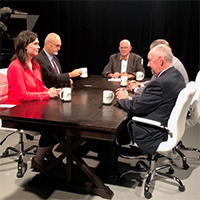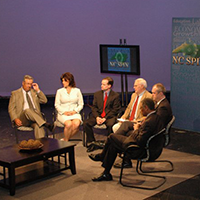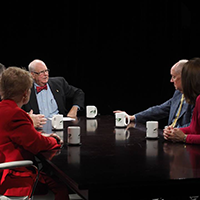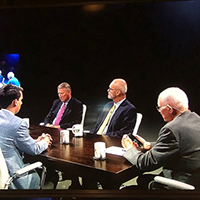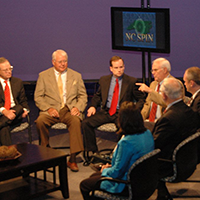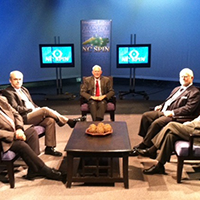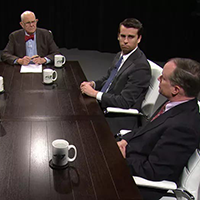Clean debate underscored deep divides
Published October 9, 2014
by Rob Christensen, News and Observer, October 8, 2014.
Thom Tillis addressed his opponent respectfully as “Sen. Hagan” and not the more familiar “Kay,” but that was about the only quarter either candidate gave each other in Tuesday night’s televised Senate debate.
In their first debate held in September, Tillis, the Republican state House speaker played the aggressor, often putting Sen. Kay Hagan, the Democratic incumbent, on the defensive. A number of analysts gave Tillis a slight edge.
But this time, Hagan stood toe-to-toe with Tillis, in a tough but clean debate that underscored the deep polarization of American politics. And this time, it appeared that Hagan at least held her own, if not better.
“It was a little bit stronger (debate) by Kay Hagan than by Thom Tillis,” said Michael Bitzer, a Catawba College political science professor and blogger.
“It was kind of a repeat of what we saw a month ago with the talking points on point and pretty much talking past each other,” Bitzer said. “It was certainly much more aggressive on both sides. But Hagan had a lot more behind her punches, I thought.”
From the very opening of the debate, broadcast statewide, it appeared that Hagan was determined to be more aggressive, accusing Tillis of wanting to take the “destructive agenda” that he pushed in the state legislature to Washington.
The debate then settled into campaign talking points – with the Republican seeking to nationalize the race and run against an unpopular president and the Democrat seeking to localize it and run against an unpopular legislature. At times, it was difficult to determine whether Tillis was running against Hagan or President Barack Obama.
Hagan spent so much time attacking Tillis’ legislative record – particularly on education – that she sounded more like a candidate for governor than for the U.S. Senate.
“I thought it was a better debate than the first debate,” said David McLennan, a political science professor at Meredith College. “Both candidates seemed to be on their games. I thought particularly Kay Hagan was much sharper and much better prepared but still more personable than in the first debate.”
But as hard-hitting as the attacks were, the debate was clean. Neither candidate got into various ethical issues that have been raised in news stories. Nor did either candidate commit any egregious errors.
After prompting criticism about whether he was being patronizing by calling Hagan “Kay” in the first debate, Tillis reverted to addressing her as Sen. Hagan on Tuesday.
The question is whether the debate changed any minds. The first debate held Sept. 3, drew only a small audience and had little effect on the race. This debate was perhaps more important for Tillis, whom several recent polls has shown trailing Hagan by an average of 4 percentage points and who needs a game-changer.
It was clear from the debate – as well as from the ad campaigns – that Tillis hopes the terrorist attacks by the Islamic State will be the issue that will turn the election in his favor.
Tillis continually drove Hagan on why she had missed half of the Senate Armed Services Committee meetings on the issue. But Hagan responded by saying that Tillis had no plan on how to deal with the terrorists.
Bitzer said it was hard to see how the debate would sway many votes. At best, he said, it might help reinforce the votes of committed Democrats or Republicans.
“It was a good debate,” McLennan said, “but I don’t think it was a game-changer by any stretch.”
http://www.newsobserver.com/2014/10/07/4215498/christensen.html

